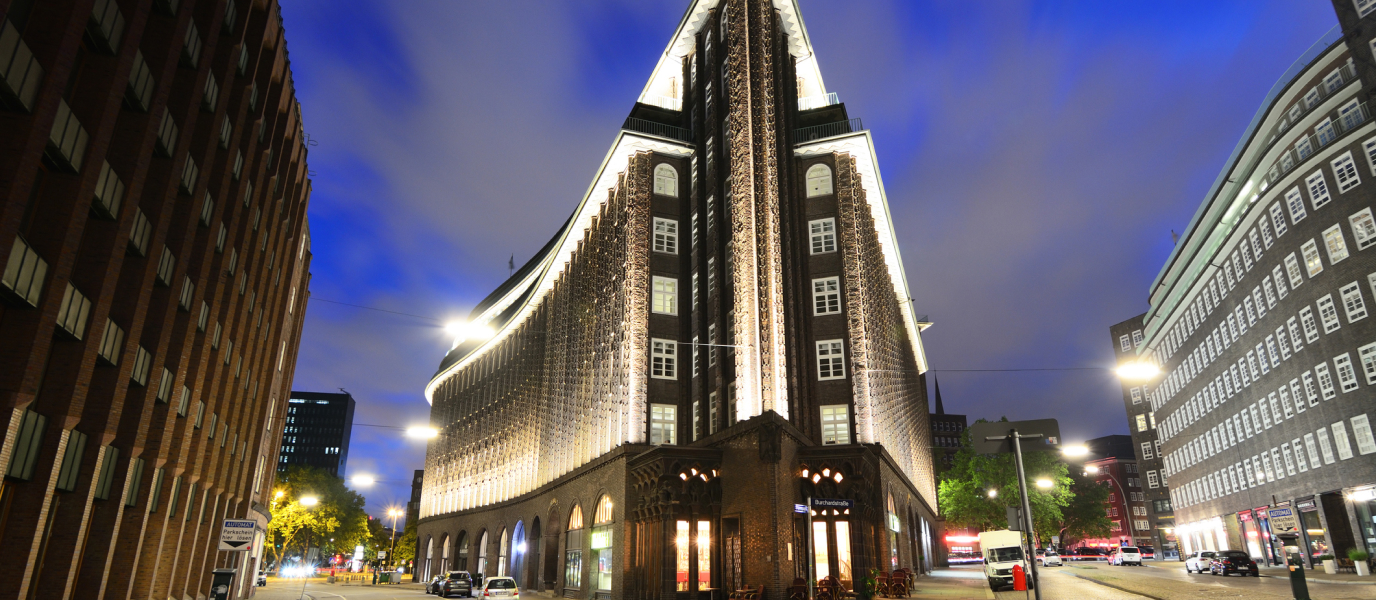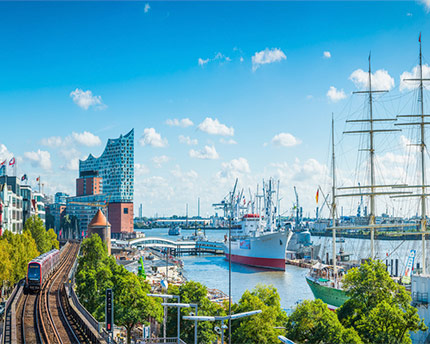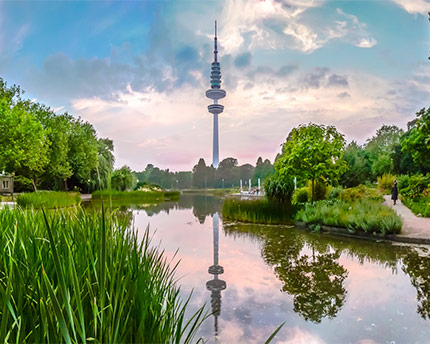Hamburg is a city built on two pillars; the first is its quirky geography, marked out by the rivers Elbe, Alster and Bille, and by countless canals, wharves, jetties, small water courses, lakes — and over 2,400 bridges! This has earned it the sobriquet ‘Venice of the north’. The second pillar is its long and remarkable history as a Free and Imperial City and its key role in the powerful Hanseatic League. These titles emphasise, among other things, the city’s enormous wealth, generated by its status as a point of departure and also of arrival — due to its huge port which has, since the Middle Ages, been a genuine means of connecting with the rest of the world.
In any case, this, Germany’s second most populous city, offers an intoxicating cocktail of attractions, from its fascinating culture to endless options for shopping, its gastronomy, its exceptionally rich natural surroundings… and a host of other reasons that make travelling here worthwhile.
Below you will find some answers to the key questions for your next short break or well-deserved holiday in this wonderful German city: What to see in Hamburg?
Hamburg Town Hall: a historic symbol
To start at the beginning, nothing can beat a visit to the ‘zero-kilometre’ attraction of this old German city-state (the city of Hamburg, which includes 7 boroughs and just about covers 750 km2, is one of Germany’s 16 federal states), its imposing Rathaus or Town Hall. This eclectic, Neo-Renaissance edifice, which opened in 1897, is not only home to the city’s government, but also the seat of Hamburg’s Parliament and Senate.
It is said that this massive edifice (133 metres wide, 70 metres deep and 112 metres tall), is held up by 4,000 wooden stilts sunk into the mud on the bank of the Alster lake. What is beyond doubt is that this iconic, lavishly-decorated building is open to the public, and that visitors can get to know every part of it by means of interesting guided tours, or through the various exhibitions inside.
Moreover, the area around the Town Hall offers all kinds of attractions, from the buildings of the Hamburg Stock Exchange and the Chamber of Trade to the inner Alster lake and the Rathausmarkt, or Town Hall square, which is regularly the site of fairs, markets, concerts and many other events.
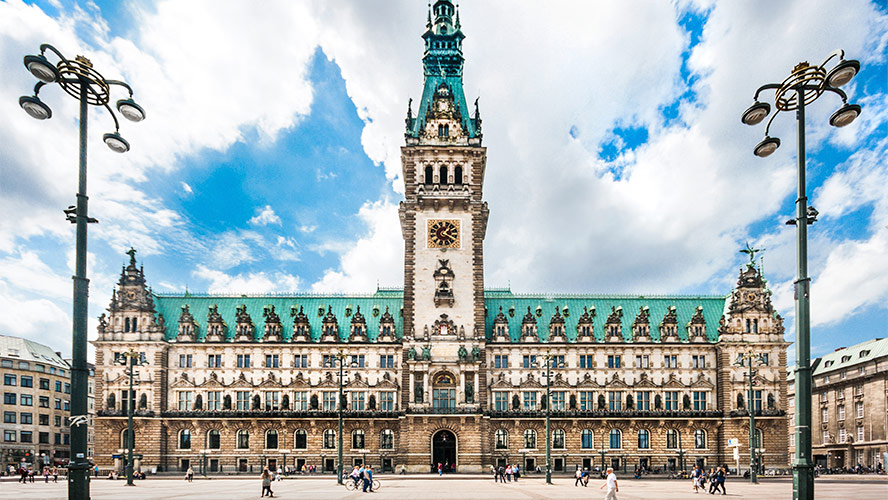
Speicherstadt, a World Heritage Site
Very close to the Town Hall, towards the bank of the Elbe, stands one of the city’s genuine historic jewels, the world’s biggest complex of port warehouses, known as Speicherstadt — literally, ‘the Town of Warehouses’. A UNESCO World Heritage Site, this enormous, 260,000 m2, neo-Gothic complex was built between 1883 and 1920 to drive the activity of the customs-free zone of the Port of Hamburg.
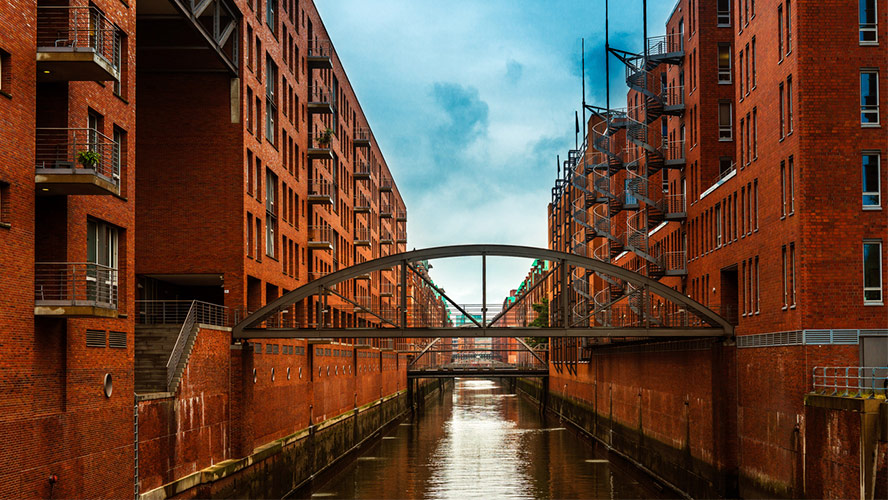
Nowadays, having survived the Second World War bombings almost intact, the Speicherstadt is home to various cultural installations, including Miniatur Wunderland, the world’s largest miniature model railway; Hamburg Dungeon, an entertaining tour of some of the city’s most important historic events, bringing together a fantastic team of actors, special effects, scenery and mechanical games; the German Customs’ Museum and the Maritime Museum. The latter is housed in the area’s oldest warehouse, and holds a particularly impressive collection of art and other exhibits relating to the sea and the world of sailing.
Of course, the Speicherstadt area is an extraordinary place simply to wander around, with its iconic red brick buildings, canals, jetties, bridges and that distinctive atmosphere only found in old ports, places that have seen people from all corners of Earth come and go.
Chilehaus: Espressionist architecture
The Declaration recognising the Speicherstadt as a World Heritage Site also includes the Kontorhaus area’s port offices, and in particular, the building known as Chilehaus. This fabulous gem of 1920s Expressionist architecture, with its remarkable silhouette in the form of the prow of a boat, is one of Germany’s most famous buildings.
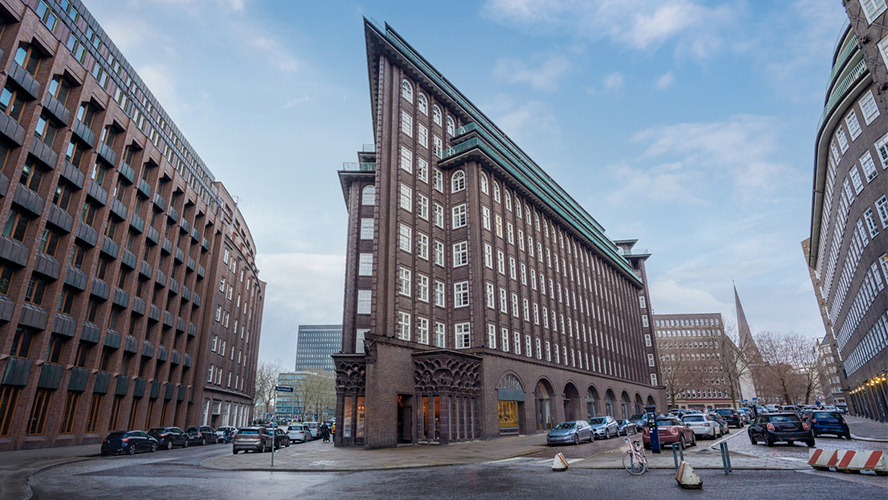
The work of the architect Fritz Höger, this 10-storey edifice is made from reinforced concrete and almost 5 million dark-coloured bricks. It was commissioned by the magnate Henry B. Sloman, a British businessman who had settled in Hamburg, and made his fortune importing saltpetre from Chile — hence the name of the building. The Chilehaus is a clear symbol of the economic recovery enjoyed by the city after the First World War, as well as being one of its most emblematic buildings.
The Elbe Philharmonic, an icon of the future
If the Speicherstadt and the Chilehaus building underline the wealth of a not-so-distant past on the bank of the Elbe, this iconic edifice, located in the same area, confirms the city’s unstoppable race into the future. The magnificent Elbphilharmonie the Elbe Philharmonic concert hall — affectionately known as the Elphi —is the work of the prestigious architectural firm Herzog & de Meuron, and forms part of the great HafenCity regeneration project in the port of Hamburg.
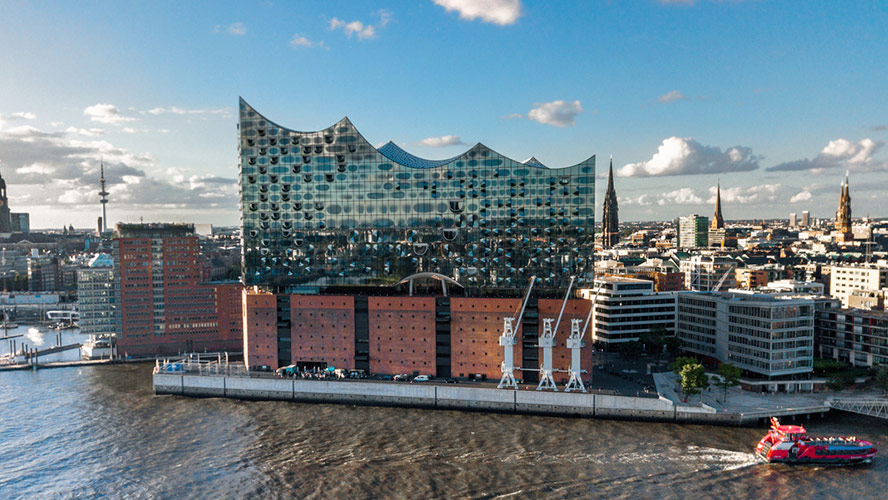
With 26 levels and standing over 100 metres tall, the building presents an impressive sight from almost any corner of the city. The lower part incorporates the red brick façade of a former port warehouse (Kaispeicher A), while the upper part is a bold structure made from glass panels, curving and cut into sections, and resembling an unfurled sail or the waves of the sea, and captures the reflection of the sky, the water and the city itself. An outstanding interplay of the traditional and the modern, which represents the true spirit of Hamburg, and whose secrets can be discovered by means of various guided tours.
Of course, the Elbphilharmonie is one of the stars of the city’s cultural calendar, thanks to the varied musical programme offered in its different halls, ranging from pure classical to jazz, in addition to its acoustic qualities (among the best in the world), but it is much more than that. The Elphi is also a social hub, and its famous Plaza — which is not at street level, but 37 metres above ground — affords one of the finest 360º panoramas of the city, the port, and other attractions.
Fischmarkt, morning hustle and bustle
Also on the bank of the Elbe, but further west, in the Altona neighbourhood, Hamburg’s fish market is an essential stop for locals and visitors alike on Sunday mornings. But take note: it is only open from 5.00 till 9.30 a.m. in the summer, and between 7.00 and 9.30 a.m. in winter, so you do need to get there early.
Since 1703, this old market with its lines of stalls has been selling fruit, flowers, clothes, and all kinds of other goods — and, of course, fish. To attract customers, the traders proclaim the virtues of their amazing wares at the top of their voices, giving rise to a noisy, entertaining business ‘debate’ that only serves to underline the unique character of the Fischmarkt. Moreover, you can do more than just shop at this market: it is also an excellent place to have breakfast in the shape of a delicious fish sandwich, among other local products, and you can listen to live music. For many people, this is the perfect spot to round off a night’s partying — or simply to enjoy the hubbub and the fantastic views of the port.
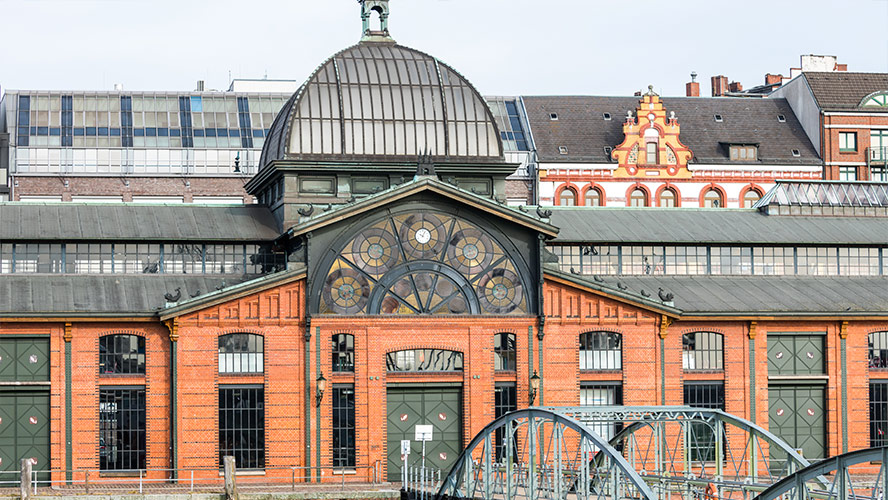
The St. Pauli neighbourhood and the party-loving Reeperbahn
And, speaking of party animals eating fish sandwiches for breakfast in the Fischmarkt, not far from this curious market you will find Hamburg’s chief party spot, the famous neighbourhood of St. Pauli, and the legendary Reeperbahn — a place where in the space of little more than one kilometre, you will find bars, clubs, restaurants, theatres, art galleries and… well, they don’t call it ‘the sinful mile’ for nothing.
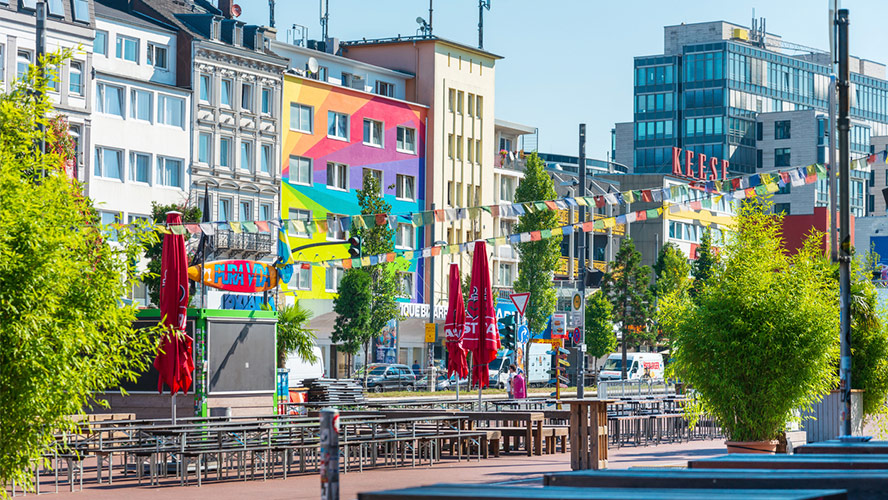
Whatever, the historic rope makers’ street (during the seventeenth and eighteenth centuries, the ropes and lines used in the port were made here) and the city’s famous red light district still remember the days when The Beatles played in the bars here, in the early 1960s, and it remains a buzzing, diverse place where every night sees performances by artists from international DJs to street musicians, and where you can have a drink in a luxury club or in a seedy sailors’ bar. In addition, every year at the end of September, the Reeperbahn Festival attracts around 25,000 visitors to Hamburg, keen to enjoy the shows, the great atmosphere, and the huge range of options on offer.
The old Elbtunnel, burrowing beneath the river
A couple of streets away from the bright, neon-lit streets of the Reeperbahn is another of Hamburg’s great attractions, the old tunnel that lies beneath the river Elbe. Built in 1911 to allow the port workers direct access from St. Pauli to the jetties on the southern bank of the river, the tunnel was in its time quite a technical achievement. It stretches for 426 metres at a depth of 24 metres beneath the surface of the river, and this fact, together with its distinctive Art Deco style, make it a dream come true for any photographer or Instagrammer worth their salt.

Nowadays, despite the addition of the ‘new’ Elbtunnel and several other bridges constructed during the 1970s, this remarkable feat of engineering is still a good way to cross the river to explore the south bank and Hamburg’s enormous port. Moreover, the views from the observation platform at the tunnel’s southern exit are genuinely spectacular.
The Port of Hamburg, seafaring charm
Hamburg has the second-largest port in Europe (only Rotterdam is bigger) and is, of course, an impressive sight. With thousands of boats, countless containers stacked one on top of another, hundreds of massive cranes, endless jetties and wharves, huge cruise ships, a whiff of faraway lands, and a unique sense of freedom, the port (looking outwards from the Elbe to the North Sea, and thence to the rest of the world) possesses a unique charm, and is one of Hamburg’s greatest attractions.
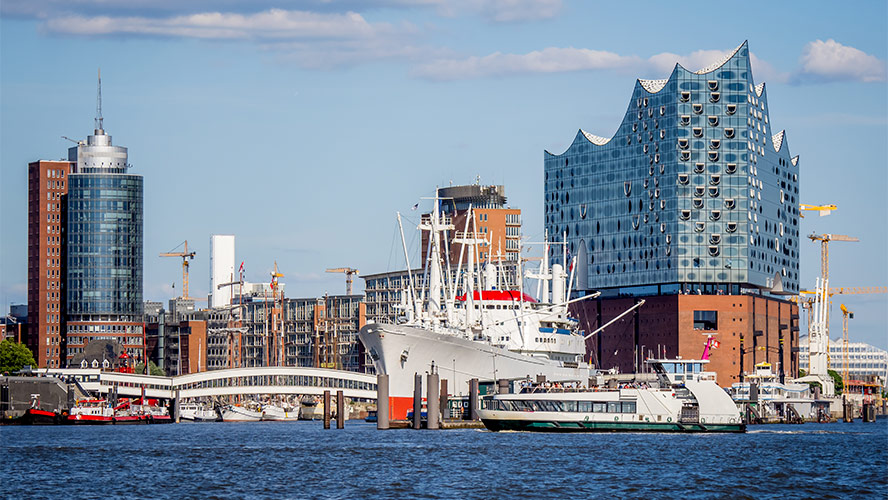
Perhaps one of the best ways to appreciate this immense maritime maze is on one of the many boat trips around the area, from the small waterways that cross the city to the river Elbe itself. There are all kinds of boat rides: hop-on and hop-off services, leisurely trips around the port at sunset, thrilling speed-boat rides, and more.
The port is also a great stage showcasing the city’s history, its culture and its vibrant artistic present. Like the area’s other great emblems (the Speicherstadt, the old Elbtunnel and the Elbphilharmonie), the port is home to various museums and impressive floating museums that relate the stories of the daring exploits of the past; to entertaining festivals such as Elbjazz and Dockville; to the Harbour Front literary festival and many others, as well as to many other events that demonstrate Hamburg’s rich maritime culture.
Deichstraße: a street steeped in history
Back on dry land, the historic streets in the city centre are another attractive facet of Hamburg. The Deichstraße (which lies between the port and the Town Hall square) is a particularly fine example of the rich historic and architectural heritage that began to take root during the seventeenth century. Some of the city’s oldest terraced houses, built in typical Hanseatic style, are now the site of restaurants and boutiques.
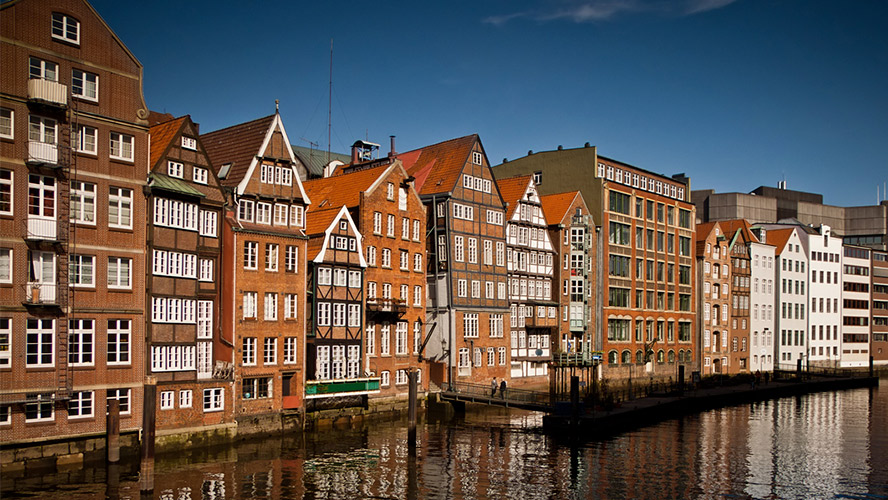
A stroll along the Deichstraße and the streets leading off it, enjoying the area’s historic charm, stopping off for lunch at any of the traditional restaurants, relaxing at a café, searching for the perfect gift to take home… To wander around Hamburg’s historic streets (such as Deichstraße, Cremon, Reimerstwiete and so many others) is to take a journey back in time.
Hamburg Dom — a party for all
Held three times a year — in spring, summer and winter — Hamburg’s emblematic DOM (internal link to Hamburg DOM) is northern Germany’s biggest public fair. Ferris wheels, helter-skelters, merry-go-rounds, fireworks… over 250 attractions for the whole family, from huge, hi-tech displays to quaint, nostalgic amusements. Each fair lasts for 4 weeks, and turns the Heiligengeistfeld fair ground, located between the St. Pauli stadium and the Große Wallanlagen park in the city centre, into a wonderland of fun and excitement.
Of course, one of the fair’s chief attractions is food, with over a hundred stalls offering everything from typical snacks and all kinds of sweets to a full-blown feast; from the famous Currywurst and traditional herring sandwiches to candyfloss and toasted almonds. And no visit to the Hamburg Dom would be complete without trying the popular Schmalzkuchen, little doughnuts, served warm with sugar or chocolate sauce. Every Hamburg DOM offers countless special events, themed areas and moments full of excitement.
Alster, the lake in the heart of the city
Water is one of Hamburg’s indisputable symbols of identity, and the Alster lakes, the Binnenalster (Inner Alster) and the Außenalster (Outer Alster), are a clear demonstration of this. Divided by the Lombardsbrücke (the Lombardy bridge) and the Kennedy bridge, the lake is in fact a reservoir formed by damming the river Alster. Since the Middle Ages, the course of Hamburg’s second most important river has been interrupted to drive the mills that were built on its banks, and to a certain extent creating the true historic centre of the city.
Nowadays, both the Binnenalster, with its huge fountain springing up from the centre of the lake to a height of around 60 metres, and the Außenalster, a much bigger body of water, are important landmarks for locals and visitors alike. Bordered by all kinds of stately mansions and historic buildings, both parts of the Alster present some of Hamburg’s most picturesque scenes: they are also a perfect spot to relax in the shade of the trees along the banks, as well as a genuine playground where people can enjoy rowing, sailing, stand-up paddle boarding, kayaking… or simply running or cycling around them.
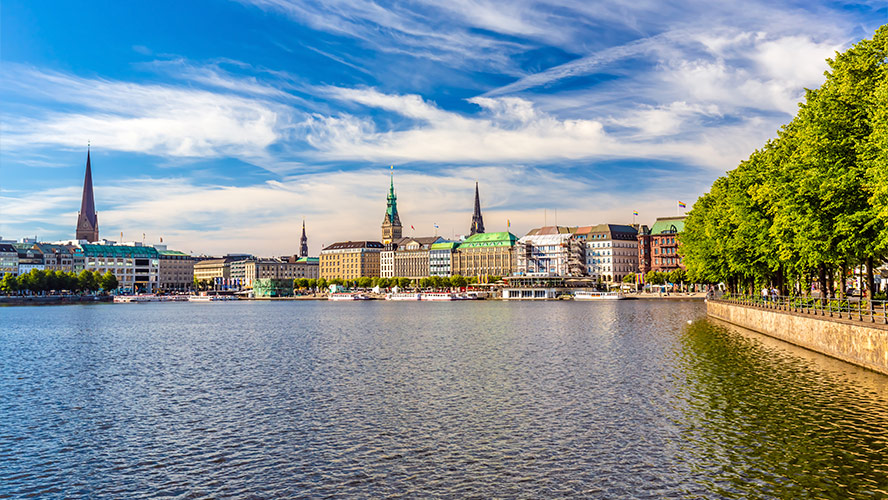
Planten un Blomen: nature in the city
The true ‘green heart’ of the city, this great urban park stretches from St. Pauli to one side of the Alster lake; it is the perfect spot to not only enjoy nature, but also to take participate in all kinds of sports, or to stroll, listen to a summer concert, have a drink, etc. Its 45 hectares hold something for everyone.
As for its design: as well as spacious lawned areas, idyllic streams and small ponds, its various themed gardens, such as the apothecary garden, with its range of medicinal plants and herbs; the Japanese garden, home to the most exotic plant species, with its picturesque tea house as the finishing touch; and the Mediterranean terraces, covered with dark slate to trap the heat from the sun and thus allow fig trees, hibiscus and lemon trees to thrive in Hamburg’s cool climate — all these are truly a sight to behold.
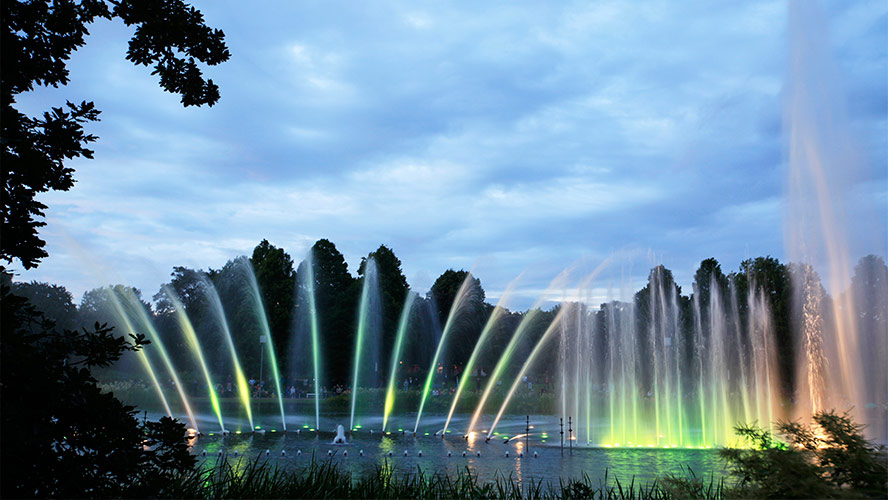
Moreover, from May until the end of October, the classical music and light show held every evening on the park’s central lake is also well worth seeing. It is not unusual to see groups of friends or families with a blanket, something to eat, and perhaps a bottle of wine… All ready to enjoy the show!
Where to eat in Hamburg
As a fine cosmopolitan city and a port connected to the rest of the world, Hamburg offers dining options for all, from haute cuisine to cute food trucks, kebabs, street food, and a whole world of other possibilities.
One of Hamburg’s classic spots to eat is, of course, Deichstraße. This street, with its historic ambience, stretches for some distance and offers numerous traditional restaurants. You should also try the fresh fish in one of the port restaurants, and the culinary delights on offer at the eateries on the shores of the Alster… Or how about a haute cuisine dinner in HafenCity? Or perhaps a more relaxed option in the diverse St. Pauli neighbourhood? The Sternschanze and Karolinenviertel districts are also a foodie paradise.
Yet another option is a picnic in Planten un Blomen, or one of the city’s many other parks, or on the banks of the Alster lake. If your visit happens to coincide with one of the three annual Hamburg DOM fairs, then you really must visit one or two of its hundred or more food stalls. But remember, Sunday mornings are for the Fischmarkt!
Another mouthwatering option is the impressive gastronomic offer at the Barceló Hamburg hotel, especially the fusion cooking at its 1700 Restaurant and Wine Bar. The restaurant serves the perfect combination of Mediterranean and German cuisine, paired with a broad selection of exclusive Spanish and local wines.





































































